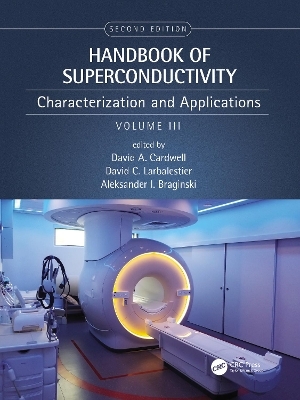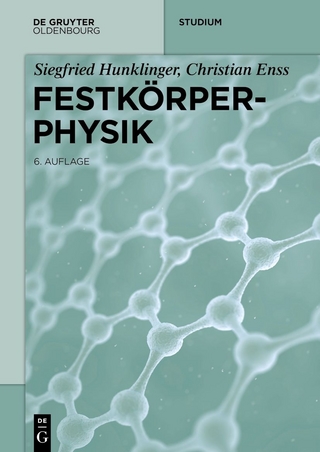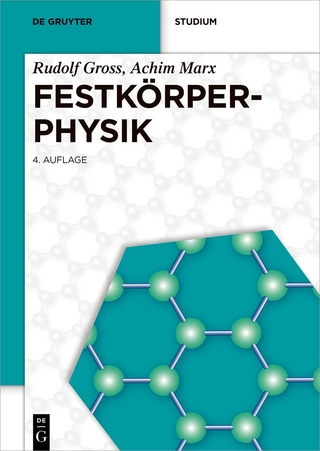
Handbook of Superconductivity
Crc Press Inc (Verlag)
978-1-4398-1736-0 (ISBN)
While the first volume covers fundamentals and various classes of materials, the second addresses processing of these into various shapes and configurations needed for applications, and ends with chapters on refrigeration methods necessary to attain the superconducting state and the desired performance. This third volume starts with a wide range of methods permitting one to characterize both the materials and various end products of processing. Subsequently, diverse classes of both large scale and electronic applications are described. Volume 3 ends with a glossary relevant to all three volumes.
Key Features:
Covers the depth and breadth of the field
Includes contributions from leading academics and industry professionals across the world
Provides hands-on familiarity with the characterization methods and offers descriptions of representative examples of practical applications
A comprehensive reference, the handbook is suitable for both graduate students and practitioners in experimental physics, materials science, and multiple engineering disciplines, including electronic and electrical, chemical, mechanical, metallurgy and others.
Professor David Cardwell, FREng, is Professor of Superconducting Engineering and Pro-Vice-Chancellor responsible for Strategy and Planning at the University of Cambridge. He was Head of the Engineering Department between 2014 and 2018. Prof. Cardwell, who established the Bulk Superconductor research group at Cambridge in 1992, has a world-wide reputation on the processing and applications of bulk high temperature superconductors. He was a founder member of the European Society for Applied Superconductivity (ESAS) in 1998 and has served as a Board member and Treasurer of the Society for the past 12 years. He is an active board member of three international journals, including Superconductor Science and Technology, and has authored over 380 technical papers and patents in the field of bulk superconductivity since 1987. He has given invited presentations at over 70 international conferences and collaborates widely around the world with academic institutes and industry. Prof. Cardwell was elected to a Fellowship of the Royal Academy of Engineering in 2012 in recognition of his contribution to the development of superconducting materials for engineering applications. He is currently a Distinguished Visiting Professor at the University of Hong Kong. He was awarded a Sc.D. by the University of Cambridge in 2014 and an honorary D.Sc. by the University of Warwick in 2015. Professor David Larbalestier is Krafft Professor of Superconducting Materials at Florida State University and Chief Materials Scientist at the National High Magnetic Field Laboratory. He was for many years Director of the Applied Superconductivity Center, first at the University of Wisconsin in Madison (1991-2006) before moving the Center to the NHMFL at Florida State University, stepping down as Director in 2018. He has been deeply interested in understanding superconducting materials that are or potentially useful as conductors and made major contributions to the understanding and betterment of Nb-Ti alloys, Nb3Sn, YBa2Cu3O7-, Bi2Sr2Ca1Cu2Ox, (Bi,Pb)2Sr2Ca2Cu3Ox, MgB2 and the Fe-based compounds. Fabrication of high field test magnets has always been an interest, starting with the first high field filamentary Nb3Sn magnets while at Rutherford Laboratory and more recently the world’s highest field DC magnet (45.5 T using a 14.5 T REBCO insert inside a 31 T resistive magnet). These works are described in ~490 papers written in partnership with more than 70 PhD students and postdocs, as well as other collaborators. He was elected to the National Academy of Engineering in 2003 and is a Fellow of the APS, IOP, IEEE, MRS and AAAS. He received his B.Sc. (1965) and Ph.D. (1970) degrees from Imperial College at the University of London and taught at the University of Wisconsin in Madison from 1976-2006. Professor Alex Braginski is retired Director of a former Superconducting Electronics Institute at the Research Center Jülich (FZJ), retired Professor of Physics at the University of Wuppertal, both in Germany, and currently a guest researcher at FZJ. He received his doctoral and D.Sc. degrees in Poland, where in early 1950s he pioneered the development of ferrite technology and subsequently their industrial manufacturing, for which he received a Polish National Prize. He headed the Polfer Research Laboratory there until leaving Poland in 1966. At the Westinghouse R&D Center in Pittsburgh, PA, USA, he then in turn managed magnetics, superconducting materials and superconducting electronics groups until retiring in 1989. Personally contributed there to technology of thin-film Nb3Ge conductors and Josephson junctions (JJs), both A15 and high-Tc, also epitaxial. Invited by FZJ, he joined it and contributed to development of high-Tc JJs and RF SQUIDs. After retiring in 1989, was Vice President R&D at Cardiomag Imaging, Inc. in Schenectady, NY, USA, 2000-2002. Co-edited and co-authored The SQUID Handbook, 2004-2006, several book chapters, and authored or co-authored well over 200 journal publications and 17 patents. He founded and served as Editor of the IEEE CSC Superconductivity News Forum (SNF), 2007-2017. Is Fellow of IEEE and APS, and recipient of the IEEE CSC Award for Continuing and Significant Contributions in the Field of Applied Superconductivity, 2006.
Foreword. Preface. Acknowledgements. Editors-in-Chief. Contributors. Part G Characterization and Modelling Techniques. G1 Introduction to Section G1: Structure/Microstructure. G1.1 X-Ray Studies: Chemical Crystallography. G1.2 X-Ray Studies: Phase Transformations and Microstructure Changes. G1.3 Transmission Electron Microscopy. G1.4 An Introduction to Digital Image Analysis of Superconductors. G1.5 Optical Microscopy. G1.6 Neutron Techniques: Flux-Line Lattice. G2 Introduction to Section G2: Measurement and Interpretation of Electromagnetic Properties. G2.1 Electromagnetic Properties of Superconductors. G2.2 Numerical Models of the Electromagnetic Behavior of Superconductors. G2.3 DC Transport Critical Currents. G2.4 Characterisation of the Transport Critical Current Density for Conductor Applications. G2.5 Magnetic Measurements of Critical Current Density, Pinning, and Flux Creep. G2.6 AC Susceptibility. G2.7 AC Losses in Superconducting Materials, Wires, and Tapes. G2.8 Characterization of Superconductor Magnetic Properties in Crossed Magnetic Fields. G2.9 Microwave Impedance. G2.10 Local Probes of Magnetic Field Distribution. G2.11 Some Unusual and Systematic Properties of Hole-Doped Cuprates in the Normal and Superconducting States. G3 Introduction to Section G3: Thermal, Mechanical, and Other Properties. G3.1 Thermal Properties: Specific Heat. G3.2 Thermal Properties: Thermal Conductivity. G3.3 Thermal Properties: Thermal Expansion. G3.4 Mechanical Properties. G3.5 Magneto-Optical Characterization Techniques. Part H Applications. H1 Introduction to Large Scale Applications. H1.1 Electromagnet Fundamentals. H1.2 Superconducting Magnet Design. H1.3 MRI Magnets. H1.4 High-Temperature Superconducting Current Leads. H1.5 Cables. H1.6 AC and DC Power Transmission. H1.7 Fault-Current Limiters. H1.8 Energy Storage. H1.9 Transformers. H1.10 Electrical Machines Using HTS Conductors. H1.11 Electrical Machines Using Bulk HTS. H1.12 Homopolar Motors. H1.13 Magnetic Separation. H1.14 Superconducting Radiofrequency Cavities. H2 Introduction to Section H2: High-Frequency Devices. H2.1 Microwave Resonators and Filters. H2.2 Transmission Lines. H2.3 Antennae. H3 Introduction to Section H3: Josephson Junction Devices. H3.1 Josephson Effects. H3.2 SQUIDs. H3.3 Biomagnetism. H3.4 Nondestructive Evaluation. H3.5 Digital Electronics. H3.6 Superconducting Analog-to-Digital Converters. H3.7 Superconducting Qubits. H4 Introduction to Radiation and Particle Detectors that Use Superconductivity. H4.1 Superconducting Tunnel Junction Radiation Detectors. H4.2 Transition-Edge Sensors. H4.3 Superconducting Materials for Microwave Kinetic Inductance Detectors. H4.4 Metallic Magnetic Calorimeters. H4.5 Optical Detectors and Sensors. H4.6 Low-Noise Superconducting Mixers for the Terahertz Frequency Range. H4.7 Applications: Metrology. Glossary. Index.
| Erscheinungsdatum | 23.11.2018 |
|---|---|
| Zusatzinfo | 45 Tables, black and white; 705 Illustrations, black and white |
| Verlagsort | Bosa Roca |
| Sprache | englisch |
| Maße | 210 x 280 mm |
| Gewicht | 1790 g |
| Themenwelt | Naturwissenschaften ► Biologie |
| Naturwissenschaften ► Physik / Astronomie ► Festkörperphysik | |
| Technik ► Elektrotechnik / Energietechnik | |
| Technik ► Umwelttechnik / Biotechnologie | |
| ISBN-10 | 1-4398-1736-7 / 1439817367 |
| ISBN-13 | 978-1-4398-1736-0 / 9781439817360 |
| Zustand | Neuware |
| Haben Sie eine Frage zum Produkt? |
aus dem Bereich


